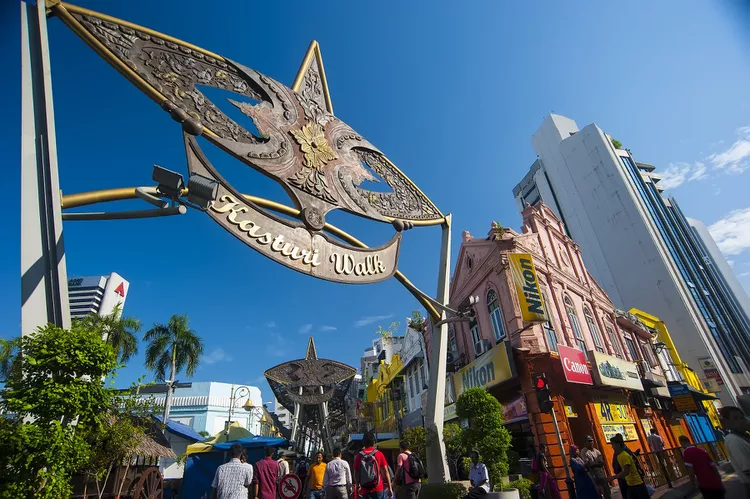Summary
Central Market History
In 1888, when the Chinese kapitan Yap Ah Loy first marked off the site where Malaysia’s Central Market stands today, the intention was to establish a “wet market” (marketplace for meat and other farm produce) to cater to the tin miners who once populated Kuala Lumpur.
Today, kapitan Yap might barely recognize the market building standing on the site today, but certainly not the building’s contents.
The present-day Central Market building houses lanes upon lanes of stalls selling a veritable Aladdin’s cave of tourist-friendly goods: antiques, kitschy pop products, cosmetics, artwork, traditional fabrics, handbags, and clothes, among others.
Given its prime location in Chinatown, travelers to Kuala Lumpur have no excuse to miss out on a Central Market shopping spree. (Site: centralmarket.com.my; location of Central Market on Google Maps.)
Shopping Streets Brimming with Culture
The place has always been called the Central Market, but its Malay name is more recent – “Pasar Seni” means “Handicraft Market”, and the building’s focus on arts and handicrafts dates back only to the 1980s, when it avoided demolition by rebranding itself as a haven for the artistically inclined.
Today, the Central Market’s 70,000 square feet of shopping space line up around themed lorong, or lanes, that reflect aspects of Malaysia’s culture.
On the ground floor, the central promenade branches to the west into Lorong India, Lorong Melayu, Lorong Cina, Lorong Kolonial, and Lorong Kelapa.
The first three lanes are named after Malaysia’s three main ethnicities – Indian, Malay, and Chinese respectively – and most stores in each lane sell products and services particular to the assigned ethnicity. Lorong India, for instance, offers sari, henna, Indian jewelry, and a wealth of handicrafts imported from as far away as Kashmir.
Lorong Kelapa specializes in stores selling traditional Malay snacks, from keropok to kueh.
Two Floors of Shopping in Central Market
A parallel lane on the eastern side of the building splits into Jonker Street and Rumah Melayu. Both lanes are lined with replicas of traditional Malaysian houses and stores hawking batik goods and Malaysian antiques.
On the mezzanine floor, the eastward corridor is a batik emporium selling Malaysian handicrafts derived from that traditional patterned cloth, while the westward corridor is divided into clothing stores and restaurants.
A food court filled with Malaysian, Indonesian, and Chinese concessions can be found here, sandwiched between a Thai restaurant and a traditional Straits coffeeshop.
Kasturi Walk’s Street Shopping Experience
The length of Jalan Hang Kasturi on the eastern side of the Central Market building was converted into a covered outdoor mall in 2012. The shopping street is lined with over fifty kiosks selling inexpensive knick-knacks, clothing, and traditional snacks.
A translucent roof overhead provides shelter from the rain while letting light through; the roof terminates at the southern end facing Petaling Street in a giant replica of a Malay kite.
Contributing to the sound of the traffic nearby, street musicians ply their trade on Jalan Kasturi as the shoppers mill about. A more regularly scheduled entertainment happens at an events stage nearby; Malaysian dance and martial arts shows are staged nightly at the Central Market at 9 pm.
Annexe Gallery’s Fine Arts Experience
An annex north of the main building that used to house a cinema now hosts a series of art galleries, including the large Annexe Gallery. The annex’s interior is also filled with performance spaces and art shops. Furthermore, the annex is used as a venue for art-related lectures, one-man shows, and art exhibits.
If you have time, you can commission a portrait of yourself at one of the shops inside the gallery or at Art Lane, the walkway between the main building and the annex.
You’ll also find the Museum of Ethnic Arts within the annex, a mini-museum of ethnic art from all around Southeast Asia and China.
What to Buy at Central Market
What you get out of shopping at Kuala Lumpur’s Central Market depends on your budget. With a few hundred bucks, you can come away with a guaranteed authentic antique from Afghanistan; a little less can buy you authentic freshwater pearls or a beautiful batik dress.
Here’s a short list of items you can blow your spending money on within Central Market’s confines:
- Batik: Malaysia has put its own spin on this patterned cloth; shops selling batik are mostly concentrated on the eastern corridor on the mezzanine floor.
- Laser-cut sculpture: Knick-knack store Arch specializes in laser-cut portraits of Asian landmarks and landscapes, carved out of wood veneer.
- Antiques: Kota Pinang on the ground floor offers a variety of antiques, including Chinese porcelain and Persian carpets.
- Pearls: The East Malaysian states of Sabah and Sarawak produce fine pearls, and Borneo Pearls specializes in hand-assembling these pearls into jewelry pieces.
- Pewter: The pewter industry in Malaysia continues to thrive, and Royal Selangor, the world’s largest pewter craft corporation, has a branch store in Central Market.
- Spa products: Tanamera sells specially-formulated bath and beauty products made from locally sourced ingredients.
- Pottery: Tenmoku offers high-quality handcrafted pottery at their stall on the Central Market’s ground floor.
How to Get to Central Market
Central Market can be found at Jalan Tun Tan Cheng Lock, just a few minutes’ walk from another popular shopping street in Chinatown, Petaling Street.
Thanks to Central Market’s central location, getting there is quite easy using public transport – you can come by train or bus. By train, take the Kelana Jaya LRT Line and disembark at Pasar Seni Station; Central Market is a short three-minute walk north from the station.
You can also use Kuala Lumpur’s Free Go KL City Bus, which terminates at the foot of Pasar Seni Station.
Central Market, Kuala Lumpur Contact Details:
Jalan Hang Kasturi, Kuala Lumpur, Malaysia ( Location on Google Maps)
Phone: +60 3 2031 0399
Email: info@centralmarket.com.my
Site: centralmarket.com.my
Operating Hours: 10 am to 10 pm





